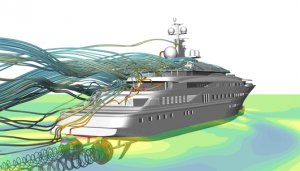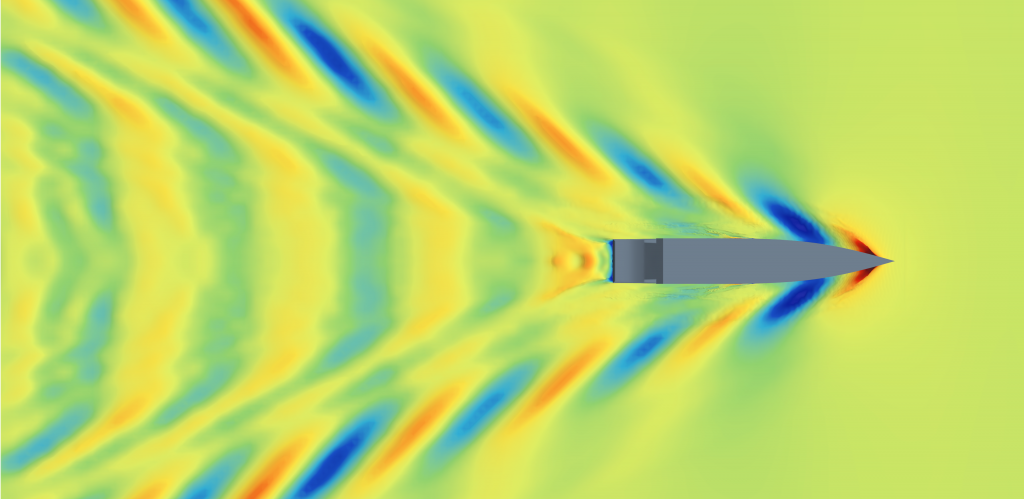Case study: CFD Simulation of an underwater yacht exhaust
with Simcenter STAR-CCM+
with Simcenter STAR-CCM+
To guarantee a streamlined yacht exterior and less exhaust noise, fuel exhausts are usually placed below the waterline. A scoop is then placed over the exhaust to manage water pressure and exhaust gasses and cooling water flow distribution. How do engineers go about assessing and optimizing these scoop designs?  At Femto Engineering we use advanced modeling methods to evaluate the effects of various flow parameters on a design. Our expertise lies in comprehensive flow modeling in combination with motion and structural components. The process of using Computation Fluid Dynamics (CFD) to predict the performance of this sort of designs is not easy, but brings great value in terms of more insight, less uncertainty, and a reduced need for extensive physical testing. Once a model is set up, engineers can test a multitude of design scenarios, resulting in higher quality designs. In this case study you can read more about such a model setup for a below waterline yacht exhaust.
At Femto Engineering we use advanced modeling methods to evaluate the effects of various flow parameters on a design. Our expertise lies in comprehensive flow modeling in combination with motion and structural components. The process of using Computation Fluid Dynamics (CFD) to predict the performance of this sort of designs is not easy, but brings great value in terms of more insight, less uncertainty, and a reduced need for extensive physical testing. Once a model is set up, engineers can test a multitude of design scenarios, resulting in higher quality designs. In this case study you can read more about such a model setup for a below waterline yacht exhaust.
The mission we set out to accomplish is two-fold. First, we want a baseline model suitable to test a variety of scoop designs on. For this we need to develop a model consisting of hot exhaust gas, cooling water, an exhaust system, the water surface, and a moving boat. The more you study these factors in unison the more accurate your simulation will be.  As stated previously, setting up such a study can be difficult and requires advanced skills and tools. Therefore, part two of our mission was to demonstrate Simcenter STAR-CCM+ capabilities for this kind of process. Simcenter STAR-CCM+ is Siemens flagship CFD software, of which we are both a user and distributor. Simulations we do at Femto Engineering involving multi-physics and complex geometries are usually done using Simcenter STAR-CCM+.
As stated previously, setting up such a study can be difficult and requires advanced skills and tools. Therefore, part two of our mission was to demonstrate Simcenter STAR-CCM+ capabilities for this kind of process. Simcenter STAR-CCM+ is Siemens flagship CFD software, of which we are both a user and distributor. Simulations we do at Femto Engineering involving multi-physics and complex geometries are usually done using Simcenter STAR-CCM+.
In this CFD simulation no scoop or hood is added to the underwater yacht exhaust. This way we can assess the behavior of exhaust gases unobtrusively leaving the exhaust and the consequences on hull contamination. This allows us to create a baseline model at which at a later point a variety of scoop designs can be factored in and virtually tested.
Our study makes use of a multiphase flow for a generic simplified yacht. The upper decks are not included for simplicity.

The yacht in our study is sailing at approximately 14 knots (7.1 m/s). The exhaust is located on the hull approximately 1 meter underneath the vessel’s waterline and has a diameter of 0.5 meter. The mass flow is 10.5 kg/s and the temperature of the gas is 60 °C. The volume flow of the exhaust gas is approximately 0.5% of the total volume flow. With simulation it is easy to adjust any of above numbers to match other possible scenarios.
For the transient CFD simulation, a Volume of Fluid (VOF) method is used, with two phases: water and air. The water is modelled as constant density while the air is modelled as a multicomponent gas, with ambient air and exhaust gas air as the components, for distinguishing purposes. The ideal gas model is used as temperature effects are present.
The behavior of the exhaust gases leaving the exhaust are shown in the animation. in the top right of the animation, the amount of exhaust gasses flowing along the hull are shown.
The CFD simulation shows the exhaust gas rising out of the water and impinging on the moving hull above the water surface, clearly demonstrating how far-up they can go.
Did we manage to setup a comprehensive baseline model? We think so. We studied several phenomena in unison, like the effect of speed on water patterns and the effects of these patterns on the exhaust outflow consisting of hot exhaust gas and cooling water. Femto has already applied this technique for a scoop optimization consultation, resulting in demonstrably better flow regulation and less hull contamination. This in turn can lead to less maintenance time for yachts in drydocks.
 It does not stop here, CFD can be applied in many other similar systems to find optimum performance and reliability parameters. With (CFD) simulation product developers can rely less on expensive trial-and-error methodology.
It does not stop here, CFD can be applied in many other similar systems to find optimum performance and reliability parameters. With (CFD) simulation product developers can rely less on expensive trial-and-error methodology.
This simulation is a good showcase of the capabilities of Simcenter STAR-CCM+ to model complex multiphase flow behavior. The ability to perform iterative design studies in a single interface significantly eased up preparing and setting up our simulation.
If you are interested in applying modeling and simulation technologies to shorten product development and design better products, reach out to us!
Would you like to read more posts like this? Follow us on LinkedIn, Twitter or YouTube for updates. We really appreciate every subscriber, comment and thumbs up. Thanks for reading.
Femto Engineering is distributor for Siemens principal CFD solutions: Simcenter STAR-CCM+ in the Benelux. Our CFD engineers use the software daily in their consultancy projects and are therefore excellent sparring and support partners. Don’t hesitate to contact us!
Do you need more information or want to discuss your project? Reach out to us anytime and we’ll happily answer your questions.
At Femto Engineering we help companies achieve their innovation ambitions with engineering consultancy, software, and R&D.
We are Siemens DISW Expert Partner for Simcenter Femap, Simcenter 3D, Simcenter Amesim, Simcenter STAR-CCM+ and SDC verifier. Get in touch and let us make CAE work for you.
Sign up for our newsletter to get free resources, news and updates monthly in your inbox. Share in our expertise!